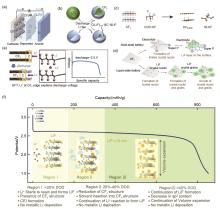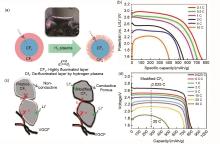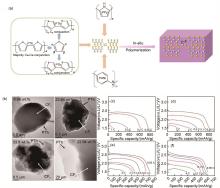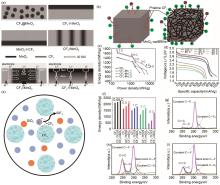Energy Storage Science and Technology ›› 2023, Vol. 12 ›› Issue (4): 1093-1109.doi: 10.19799/j.cnki.2095-4239.2022.0720
• Energy Storage Materials and Devices • Previous Articles Next Articles
Cai TANG1( ), Jiangmin JIANG1(
), Jiangmin JIANG1( ), Xinfeng WANG1, Guangfa LIU1, Yanhua CUI2(
), Xinfeng WANG1, Guangfa LIU1, Yanhua CUI2( ), Quanchao ZHUANG1(
), Quanchao ZHUANG1( )
)
Received:2022-12-02
Revised:2023-01-14
Online:2023-04-05
Published:2023-05-08
Contact:
Jiangmin JIANG, Yanhua CUI, Quanchao ZHUANG
E-mail:1585112441@qq.com;jiangmin326@163.com;cuiyanhua@netease.com;zhuangquanchao@126.com
CLC Number:
Cai TANG, Jiangmin JIANG, Xinfeng WANG, Guangfa LIU, Yanhua CUI, Quanchao ZHUANG. Research progress of Li/CF x primary batteries[J]. Energy Storage Science and Technology, 2023, 12(4): 1093-1109.

Fig. 2
(a) Structure and working principle of Li/CF x primary batteries; (b) Schematic of the "core-shell" model of Li/CF x primary battery discharge; (c) Schematics of the formation of SI-CF and thus CF L product (SI-CF and COV-CF refer to the semi-ionic and covalent CF bonds, respectively), (d) Schematics for the formation and growth processes of LiF crystal nuclei and grains in solid and liquid states batteries[28]; (e) Schematic of the Li+ edge-propagation mechanism for the lithiation process of CF x[29]; (f) The schematic of the Li/CF x system mechanism through the depth of discharge[30]"


Fig. 4
(a) Schematic of the discharge of fluorinated graphite,fluorinated carbon nanotubes,fluorinated fullerenes,and fluorinated graphene; (b) Comparison of specific capacities of (CF0.25) n and FG at different current rates,SEM photographs of (c) (CF0.25) n and (d) FG; (e) Schematic representation of lithiation of fluorinated graphite polymer and fluorinated graphene[41]"


Fig. 5
(a) Schematic drawing of the plasma treatment on CF x powders (CF y denotes the highly fluorinated layer formed in the high-temperature fluorination process); (b) CF y discharge curve after modification by plasma[63]; (c) Schematic diagram of electronic paths for pristine and modified CF x during discharge; (d) Discharge curve of CF x after modification[64]"


Fig. 6
(a) Schematic representation of the synthesis of a typical conducting polymer and CF x composite cathode material; (b) TEM and HRTEM images of CF x @PTh composites with various PTh content (8.66%, 22.94%, and 33.80 %); Galvanostatic discharge curves at different rates of (c) CF x, (d) 8.66% PTh/CF x, (e) 22.94% PTh/CF x, and (f) 33.8% PTh/CF x[67]"


Fig. 8
(a) The schematic arrangement diagrams of four kinds of CF x -MnO2 composite cathodes with different configurations (CF x @MnO2, CF x ⊕MnO2, CF x ⊕MnO2, and CF x //MnO2), accompanied with the charge transfer mechanism in CF x //MnO2[72]; (b) Schematic of electron and lithium ion pathways for CFx and CF x @MnO2-nanowire composites; (c) Ragone plots and of pristine CF x and CF x @MnO2-nanowire composites; (d) High and low temperature discharge curves of CF x /MnO2-nanowire composites at 0.1 C[74]; (e) Schematic of the reaction mechanism between CF x and SiO2; (f) Gravimetric energy densities of various CF x -based cathodes at different current densities,and high-resolution C 1s XPS spectra of (g) CF x, (h) CF x -TEOS and (i) CF x -mSiO2[75]"

| 1 | 陈淼淼, 邵钦君, 陈剑. 锂电池高比能量正极材料Cr8O21的制备及应用[J]. 储能科学与技术, 2022, 11(9): 3011-3020. |
| CHEN M M, SHAO Q J, CHEN J. Preparation and application of Cr8O21 as cathode material for high specific energy lithium batteries[J]. Energy Storage Science and Technology, 2022, 11(9): 3011-3020. | |
| 2 | XIAO Y K, JIAN J H, FU A, et al. Substantially promoted energy density of Li||CFx primary battery enabled by Li+-DMP coordinated structure[J]. ACS Sustainable Chemistry & Engineering, 2022, 10(19): 6217-6229. |
| 3 | BAN J, JIAO X X, FENG Y Y, et al. All-temperature, high-energy-density Li/CFx batteries enabled by a fluorinated ether as a cosolvent[J]. ACS Applied Energy Materials, 2021, 4(4): 3777-3784. |
| 4 | RUFF O, BRETSCHNEIDER O. Die reaktionsprodukte der verschiedenen kohlenstoffformen mitfluor ii[J]. Zeitschrift fü r anorganische und allgemeine Chemie, 1934, 217(1):1-18. |
| 5 | ZHANG Q, TAKEUCHI K J, TAKEUCHI E S, et al. Progress towards high-power Li/CFx batteries: Electrode architectures using carbon nanotubes with CFx[J]. Physical Chemistry Chemical Physics: PCCP, 2015, 17(35): 22504-22518. |
| 6 | 夏金童,陈小华,征茂平等.新型固体润滑剂──氟化石墨的制备与性能的研究[J].无机材料学报,1998(03):435-439. |
| XIA J T, CHEN X H, ZHENG M P, et al. New Type of the solid lubricant material-Preparation and properties of graphite fluoride[J]. Journal of Inorganic Materials, 1998, (03): 435-439. | |
| 7 | GUPTA V, NAKAJIMA T, OHZAWA Y. Fluorination of graphite at high temperatures[J]. Collection of Czechoslovak Chemical Communications, 2002, 67(9): 1366-1372. |
| 8 | GIRAUDET J, CLAVES D, GUÉRIN K, et al. Magnesium batteries: Towards a first use of graphite fluorides[J]. Journal of Power Sources, 2007, 173(1): 592-598. |
| 9 | NEWMAN G H, SHROPSHIRE J A. Primary cell for electric batteries: US3990915[P]. 1976-11-09. |
| 10 | GROULT H, TRESSAUD A. Use of inorganic fluorinated materials in lithium batteries and in energy conversion systems[J]. Chemical Communications (Cambridge, England), 2018, 54(81): 11375-11382. |
| 11 | GUÉRIN K, DUBOIS M, HOUDAYER A, et al. Applicative performances of fluorinated carbons through fluorination routes: A review[J]. Journal of Fluorine Chemistry, 2012, 134: 11-17. |
| 12 | 王俊, 张学全, 刘亚飞, 等. 高容量富锂锰基正极材料的研究进展[J]. 储能科学与技术, 2022, 11(10): 3051-3061. |
| WANG J, ZHANG X Q, LIU Y F, et al. Research progress of high capacity Li-Mn-rich cathode materials[J]. Energy Storage Science and Technology, 2022, 11(10): 3051-3061. | |
| 13 | ZHANG H M, LI X F, ZHANG H Z. Li-S and Li-O2 batteries with high specific energy[M]// Li-S and Li-O2 batteries with high specific energy. Singapore: Springer, 2017: 1-48. |
| 14 | BRUCE P G, FREUNBERGER S A, HARDWICK L J, et al. Li-O2 and Li-S batteries with high energy storage[J]. Nature Materials, 2012, 11(1): 19-29. |
| 15 | YAO L, ZHOU H, CHEN G, et al. Study on the thermal effect in ultra-fast plasma-enhanced fluorination for high-quality CFx cathode materials[J]. Diamond and Related Materials, 2023, 131: doi: 10.1016/j.diamond.2022.109545. |
| 16 | GOMADAM P M, MERRITT D R, SCOTT E R, et al. Modeling lithium/hybrid-cathode batteries[J]. Journal of Power Sources, 2007, 174(2): 872-876. |
| 17 | 陈雨晴, 张洪章, 于滢, 等. 锂硫一次电池的研究现状及展望[J]. 储能科学与技术, 2017, 6(3): 529-533. |
| CHEN Y Q, ZHANG H Z, YU Y, et al. The R & D status and prospects for primary lithium sulfur batteries[J]. Energy Storage Science and Technology, 2017, 6(3): 529-533. | |
| 18 | ZHU D L, YUAN J C, DAI Y, et al. High-rate performance of fluorinated carbon material doped by phosphorus species for lithium-fluorinated carbon battery[J]. Energy Technology, 2022, 10(6): doi: 10.1002/ente.202200155. |
| 19 | GIRAUDET J, DELABARRE C, GUÉRIN K, et al. Comparative performances for primary lithium batteries of some covalent and semi-covalent graphite fluorides[J]. Journal of Power Sources, 2006, 158(2): 1365-1372. |
| 20 | CHEN K M, MERRITT D R, HOWARD W G, et al. Hybrid cathode lithium batteries for implantable medical applications[J]. Journal of Power Sources, 2006, 162(2): 837-840. |
| 21 | DREWS J, FEHRMANN G, STAUB R, et al. Primary batteries for implantable pacemakers and defibrillators[J]. Journal of Power Sources, 2001, 97: 747-749. |
| 22 | RODRIGUEZ M A, KEENAN M R, NAGASUBRAMANIAN G. in situ X-ray diffraction analysis of (CFx) nbatteries: Signal extraction by multivariate analysis[J]. Journal of Applied Crystallography, 2007, 40(6): 1097-1104. |
| 23 | WHITACRE J F, WEST W C, SMART M C, et al. Enhanced low-temperature performance of Li-CFx batteries[J]. Electrochemical and Solid-State Letters, 2007, 10(7): A166. |
| 24 | WAITTIN GHAM MS.Mechanism of reduction of the fluorographite cathode[J]. Journal of the Electrochemical Society, 1975, 122(4): 526. |
| 25 | WATANABE N, HAGIWARA R, NAKAJIMA T, et al. Solvents effects on electrochemical characteristics of graphite fluoride—Lithium batteries[J]. Electrochimica Acta, 1982, 27(11): 1615-1619. |
| 26 | WATANABE N, NAKAJIMA T, HAGIWARA R. Discharge reaction and overpotential of the graphite fluoride cathode in a nonaqueous lithium cell[J]. Journal of Power Sources, 1987, 20(1/2): 87-92. |
| 27 | ZHANG S S, FOSTER D, WOLFENSTINE J, et al. Electrochemical characteristic and discharge mechanism of a primary Li/CFx cell[J]. Journal of Power Sources, 2009, 187(1): 233-237. |
| 28 | ZHONG G M, CHEN H X, CHENG Y, et al. Insights into the lithiation mechanism of CFx by a joint high-resolution 19F NMR, in situ TEM and 7Li NMR approach[J]. Journal of Materials Chemistry A, 2019, 7(34): 19793-19799. |
| 29 | LEUNG K, SCHORR N B, MAYER M, et al. Edge-propagation discharge mechanism in CFx batteries-a first-principles and experimental study[J]. Chemistry of Materials, 2021, 33(5):1760-1770. |
| 30 | SAYAHPOUR B, HIRSH H, BAI S, et al. Revisiting discharge mechanism of CFx as a high energy density cathode material for lithium primary battery[J]. Advanced Energy Materials, 2022, 12(5): doi: 10.1002/aenm.202103196. |
| 31 | GUÉRIN K, PINHEIRO J P, DUBOIS M, et al. Synthesis and characterization of highly fluorinated graphite containing sp2 and sp3 carbon[J]. Chemistry of Materials, 2004, 16(9): 1786-1792. |
| 32 | 百华. 氟化石墨纤维[J]. 化工新型材料, 1988, 16(11): 25-28. |
| BAI H. Fluorinated graphite fiber[J]. New Chemical Materials, 1988, 16(11): 25-28. | |
| 33 | CHAMSSEDINE F, DUBOIS M, GUERIN K, et al. Reactivity of carbon nanofibers with fluorine gas[J]. Chemistry of Materials, 2007, 19(2):161-172. |
| 34 | ZHOU R X, LI Y, FENG Y Y, et al. The electrochemical performances of fluorinated hard carbon as the cathode of lithium primary batteries[J]. Composites Communications, 2020, 21: doi: 10.1016/j.coco.2020.100396. |
| 35 | AHMAD Y, DUBOIS M, GUERIN K, et al. High energy density of primary lithium batteries working with sub-fluorinated few walled carbon nanotubes cathode[J]. Journal of Alloys and Compounds, 2017, 726: 852-859. |
| 36 | JAYASINGHE R, THAPA A K, DHARMASENA R R, et al. Optimization of multi-walled carbon nanotube based CFx electrodes for improved primary and secondary battery performances[J]. Journal of Power Sources, 2014, 253: 404-411. |
| 37 | NAKAJIMA T, MATSUO Y, ŽEMVA B, et al. Synthesis of fluorine-graphite intercalation compounds by elemental fluorine and high oxidation-state transition-metal fluorides[J]. Carbon, 1996, 34(12): 1595-1598. |
| 38 | CLAVES D, GIRAUDET A J, HAMWI A, et al. Structural, bonding, and electrochemical properties of perfluorinated fullerene C70[J]. Journal of Physical Chemistry B, 2001, 105: 1739-1742. |
| 39 | HAMWI A. Fluorine reactivity with graphite and fullerenes[J]. Journal of Physics & Chemistry of Solids, 1996, 57(6-8):677-688. |
| 40 | MEDURI P, CHEN H H, XIAO J, et al. Tunable electrochemical properties of fluorinated graphene[J]. Journal of Materials Chemistry A, 2013, 1(27): 7866-7869. |
| 41 | DAMIEN D, SUDEEP P M, NARAYANAN T N, et al. Fluorinated graphene based electrodes for high performance primary lithium batteries[J]. RSC Advances, 2013, 3(48): 25702-25706. |
| 42 | BI X, LI Y Y, QIU Z P, et al. Fluorinated graphene prepared by direct fluorination of N, O-doped graphene aerogel at different temperatures for lithium primary batteries[J]. Materials (Basel, Switzerland), 2018, 11(7): 1072. |
| 43 | WATANABE N. Two types of graphite fluorides, (CF)n and (C2F)n, and discharge characteristics and mechanisms of electrodes of (CF)n and (C2F)n in lithium batteries[J]. Solid State Ionics, 1980, 1(1/2): 87-110. |
| 44 | YAZAMI R, HAMWI A. A new graphite fluoride compound as electrode material for lithium intercalation in solid state cells[J]. Solid State Ionics, 1988, 28: 1756-1761. |
| 45 | HAGIWARA R, LERNER M, BARTLETT N, et al. A lithium/C2F primary battery[J]. Journal of The Electrochemical Society, 1988, 135(9): 2393-2394. |
| 46 | NAKAJIMA T, KOH M, GUPTA V, et al. Electrochemical behavior of graphite highly fluorinated by high oxidation state complex fluorides and elemental fluorine[J]. Electrochimica Acta, 2000, 45(10): 1655-1661. |
| 47 | SATO Y, ITOH K, HAGIWARA R, et al. On the so-called "semi-ionic" C-F bond character in fluorine-GIC[J]. Carbon, 2004, 42(15): 3243-3249. |
| 48 | HANY P, YAZAMI R, HAMWI A. Low-temperature carbon fluoride for high power density lithium primary batteries[J]. Journal of Power Sources, 1997, 68(2): 708-710. |
| HANY P, YAZAMI R, HAMWI A. Low-temperature carbon fluoride for high power density lithium primary batteries[J]. Journal of Power Sources, 1997, 68(2): 708-710. | |
| 49 | NAZAROV A S, MAKOTCHENKO V G. Dicarbon monofluoride: A solid host for containment of volatiles[J]. Inorganic Materials, 2002, 38(3): 278-282. |
| 50 | GUPTA V, NAKAJIMA T, OHZAWA Y, et al. A study on the formation mechanism of graphite fluorides by Raman spectroscopy[J]. Journal of Fluorine Chemistry, 2003, 120(2): 143-150. |
| 51 | AMATUCCI G G, PEREIRA N. Fluoride based electrode materials for advanced energy storage devices[J]. Journal of Fluorine Chemistry, 2007, 128(4): 243-262. |
| 52 | READ J A, BEHL W K. Mechanochemical synthesis of carbon fluorides[J]. Electrochemical and Solid State Letters, 2008, 12(1): A16-A18. |
| 53 | NAKAJIMA T. Fluorine compounds as energy conversion materials[J]. Journal of Fluorine Chemistry, 2013, 149: 104-111. |
| 54 | DELABARRE C, DUBOIS M, GIRAUDET J, et al. Electrochemical performance of low temperature fluorinated graphites used as cathode in primary lithium batteries[J]. Carbon, 2006, 44(12): 2543-2548. |
| 55 | FULVIO P F, BROWN S S, ADCOCK J, et al. Low-temperature fluorination of soft-templated mesoporous carbons for a high-power lithium/carbon fluoride battery[J]. Chemistry of Materials, 2011, 23(20):4420-4427. |
| 56 | LEROUX F, DUBOIS M. Origin of the highly enhanced porosity of styryl LDH hybrid-type carbon replicas and study of a subsequent fluorination at low-temperature[J]. Journal of Materials Chemistry, 2006, 16(46): 4510-4520. |
| 57 | PARMENTIER J, SCHLIENGER S, DUBOIS M, et al. Structural/textural properties and water reactivity of fluorinated activated carbons[J]. Carbon, 2012, 50(14): 5135-5147. |
| 58 | MATEI GHIMBEU C, GUERIN K, DUBOIS M, et al. Insights on the reactivity of ordered porous carbons exposed to different fluorinating agents and conditions[J]. Carbon, 2015, 84: 567-583. |
| 59 | 夏金童, 征茂平, 何莉萍, 等. 氟化石墨制备新工艺的研究[J]. 湖南大学学报(自然科学版), 1999, 26(1): 29-32. |
| XIA J T, ZHENG M P, HE L P, et al. A study on the preparation of graphite fluoride by the new technology[J]. Journal of Hunan University (Natural Science), 1999, 26(1): 29-32. | |
| 60 | YAZAMI R, HAMWI A, GUÉRIN K, et al. Fluorinated carbon nanofibres for high energy and high power densities primary lithium batteries[J]. Electrochemistry Communications, 2007, 9(7): 1850-1855. |
| 61 | ADCOCK J L, FULVIO P F, DAI S. Towards the selective modification of soft-templated mesoporous carbon materials by elemental fluorine for energy storage devices[J]. Journal of Materials Chemistry A, 2013, 1(33): 9327-9331. |
| 62 | FULVIO P F, VEITH G M, ADCOCK J L, et al. Fluorination of âbrick and mortarâ soft-templated graphitic ordered mesoporous carbons for high power lithium-ion battery[J]. Journal of Materials Chemistry A, 2013, 1(33): 9414-9417. |
| 63 | CHEN G T, ZHOU H P, ZHANG S, et al. Surface de-fluorination and bond modification of CFx by high-density hydrogen plasma processing[J]. ACS Applied Energy Materials, 2021, 4(8): 8615-8620. |
| 64 | DAI Y, CAI S D, WU L J, et al. Surface modified CFx cathode material for ultrafast discharge and high energy density[J]. Journal of Materials Chemistry A, 2014, 2(48): 20896-20901. |
| 65 | GROULT H, JULIEN C M, BAHLOUL A, et al. Improvements of the electrochemical features of graphite fluorides in primary lithium battery by electrodeposition of polypyrrole[J]. Electrochemistry Communications, 2011, 13(10): 1074-1076. |
| 66 | LI L, ZHU L, PAN Y, et al. Integrated polyaniline-coated CFx cathode materials with enhanced electrochemical capabilities for Li/CFx primary battery[J]. International Journal of Electrochemical Science, 2016, 11(8):6838-6847. |
| 67 | YIN X D, LI Y, FENG Y Y, et al. Polythiophene/graphite fluoride composites cathode for high power and energy densities lithium primary batteries[J]. Synthetic Metals, 2016, 220: 560-566. |
| 68 | WANG X Z, HO J W, YANG Q Y, et al. Performance enhancement in organic photovoltaic devices using plasma-polymerized fluorocarbon-modified Ag nanoparticles[J]. Organic Electronics, 2011, 12(11): 1943-1947. |
| 69 | ZHANG L X, ZHANG L J, XILI D G, et al. CFx-Cu composites with excellent high rate performances as cathode materials for lithium primary batteries[J]. Rare Metal Materials and Engineering, 2020, 49(7):2256-2261. |
| 70 | ZHANG L X, ZHANG L J, XI L D G. Facile fabrication of CFx-Pt composites as a high-performance cathode for primary lithium batteries[J]. International Journal of Electrochemical Science, 2019, 14(6):5738-5747. |
| 71 | ZHANG L X, ZHANG L J, XILI D G, et al. CFx-Ru composite cathode for lithium primary battery with significantly improved electrochemical performance[J]. Chinese Journal of Inorganic Chemistry, 2020, 36(1):148-158. |
| 72 | LI Y, FENG W. The tunable electrochemical performances of carbon fluorides/Manganese dioxide hybrid cathodes by their arrangements[J]. Journal of Power Sources, 2015, 274: 1292-1299. |
| 73 | CHANG Y L, WANG M, WANG S P, et al. Ultralong storage life of Li/MnO2 primary batteries using MnO2-(CFx)n with C-F semi-ionic bond as cathode materials[J]. Electrochimica Acta, 2019, 320: doi: 10.1016/j.electacta.2019.134618 |
| 74 | LUO Z Y, WAN J, LEI W X, et al. A simple strategy to synthesis CFx@MnO2-nanowires composite cathode materials for high energy density and high power density primary lithium batteries[J]. Materials Technology, 2020, 35(13/14): 836-842. |
| 75 | ZHU Y L, ZHANG L J, ZHAO H H, et al. Significantly improved electrochemical performance of CFx promoted by SiO2 modification for primary lithium batteries[J]. Journal of Materials Chemistry A, 2017, 5(2): 796-803. |
| 76 | NAGASUBRAMANIAN G, SANCHEZ B. A new chemical approach to improving discharge capacity of Li/(CFx)n cells[J]. Journal of Power Sources, 2007, 165(2): 630-634. |
| 77 | LI Q, XUE W R, SUN X R, et al. Gaseous electrolyte additive BF3 for high-power Li/CFx primary batteries[J]. Energy Storage Materials, 2021, 38: 482-488. |
| 78 | IGNATOVA A A, YARMOLENKO O V, TULIBAEVA G Z, et al. Influence of 15-crown-5 additive to a liquid electrolyte on the performance of Li/CFx-Systems at temperatures up to -50 ℃[J]. Journal of Power Sources, 2016, 309: 116-121. |
| 79 | LONG S T, CHEN F, DING F, et al. Study on crystal growth kinetics and preferred orientation for LiF crystal in dimethyl sulfoxide/1, 3-dioxolane-based electrolyte[J]. The Journal of Physical Chemistry C, 2019, 123(46): 28048-28057. |
| 80 | FANG Z, YANG Y, ZHENG T L, et al. An all-climate CFx/Li battery with mechanism-guided electrolyte[J]. Energy Storage Materials, 2021, 42: 477-483. |
| [1] | Zhiwen WANG, Qiang YE. Investigation of the mixing loss and guiding strategy of the electrolyte flow in the tanks of a redox flow battery system [J]. Energy Storage Science and Technology, 2023, 12(4): 1148-1157. |
| [2] | Weibin HUANG, Biao ZHANG, Jincheng FAN, Wei YANG, Hanbo ZOU, Shengzhou CHEN. Preparation and modification of ZIF-8 composite PEO based solid electrolyte [J]. Energy Storage Science and Technology, 2023, 12(4): 1083-1092. |
| [3] | Xiaoyu SHEN, Jing ZHU, Guanjun CEN, Ronghan QIAO, Junfeg HAO, Mengyu TIAN, Hongxiang JI, Zhou JIN, Yida WU, Yuanjie ZHAN, Yong YAN, Liubin BEN, Hailong YU, Yanyan LIU, Xuejie HUANG. Reviews of selected 100 recent papers for lithium batteries (Dec. 1, 2022 to Jan. 31, 2023) [J]. Energy Storage Science and Technology, 2023, 12(3): 639-653. |
| [4] | Mai FENG, Nan CHEN, Renjie CHEN. Research progress of low-temperature electrolyte for lithium-ion battery [J]. Energy Storage Science and Technology, 2023, 12(3): 792-807. |
| [5] | Kaiyuan XUE, Yan WANG, Junwei LANG, Tian HE, Zuoqiang DAI, Zongmin ZHENG. The progress in applications of dicationic ionic liquids in the energy storage and conversion system [J]. Energy Storage Science and Technology, 2023, 12(3): 808-821. |
| [6] | Zezheng WANG, Wenhao QU, Yajun WANG, Run QIN, Yibing LIU. Simulation and stress analysis of large capacity composite flywheel rotor [J]. Energy Storage Science and Technology, 2023, 12(3): 669-675. |
| [7] | Huimin ZHANG, Jing WANG, Yibo WANG, Jiaxin ZHENG, Jingyi QIU, Gaoping CAO, Hao ZHANG. Multiscale modeling of the SEI of lithium-ion batteries [J]. Energy Storage Science and Technology, 2023, 12(2): 366-382. |
| [8] | Mengyu TIAN, Yida WU, Junfeng HAO, Jing ZHU, Guanjun CEN, Ronghan QIAO, Xiaoyu SHEN, Hongxiang JI, Zhou JIN, Yuanjie ZHAN, Yong YAN, Liubin BEN, Hailong YU, Yanyan LIU, Xuejie HUANG. Reviews of selected 100 recent papers for lithium batteries (Oct. 1, 2022 to Nov. 30, 2022) [J]. Energy Storage Science and Technology, 2023, 12(1): 1-15. |
| [9] | Ziwei YUAN, Chuyuan LIN, Ziyan YUAN, Xiaoli SUN, Qingrong QIAN, Qinghua CHEN, Lingxing ZENG. The research process on low temperature performance of zinc ion batteries [J]. Energy Storage Science and Technology, 2023, 12(1): 278-298. |
| [10] | Jing ZHU, Yida WU, Junfeng HAO, Guanjun CEN, Ronghan QIAO, Xiaoyu SHEN, Mengyu TIAN, Hongxiang JI, Zhou JIN, Yuanjie ZHAN, Yong YAN, Liubin BEN, Hailong YU, Yanyan LIU, Xuejie HUANG. Reviews of selected 100 recent papers for lithium batteries (Jun. 1, 2022 to Jul. 31, 2022) [J]. Energy Storage Science and Technology, 2022, 11(9): 3035-3050. |
| [11] | Jun ZHANG, Qi LI, Ying TAO, Quanhong YANG. Sieving carbons for sodium-ion batteries: Origin and progress [J]. Energy Storage Science and Technology, 2022, 11(9): 2825-2833. |
| [12] | Jinghua WU, Jing YANG, Gaozhan LIU, Zhiyan WANG, Zhihua ZHANG, Hailong YU, Xiayin YAO, Xuejie HUANG. Review and prospective of solid-state lithium batteries in the past decade (2011—2021) [J]. Energy Storage Science and Technology, 2022, 11(9): 2713-2745. |
| [13] | Pengbo ZHAI, Dongmei CHANG, Zhijie BI, Ning ZHAO, Xiangxin GUO. Research progress on key interfacial issues in lithium lanthanum zirconium oxide-based solid-state [J]. Energy Storage Science and Technology, 2022, 11(9): 2847-2865. |
| [14] | Qunbin ZHANG, Tao DONG, Jingjing LI, Yanxia LIU, Haitao ZHANG. Research progress on the recovery and high-value utilization of spent electrolyte from lithium-ion batteries [J]. Energy Storage Science and Technology, 2022, 11(9): 2798-2810. |
| [15] | Xiaoyu SHEN, Guanjun CEN, Ronghan QIAO, Jing ZHU, Hongxiang JI, Mengyu TIAN, Zhou JIN, Yong YAN, Yida WU, Yuanjie ZHAN, Hailong YU, Liubin BEN, Yanyan LIU, Xuejie HUANG. Reviews of selected 100 recent papers for lithium batteries (Apr. 1, 2022 to May 31, 2022) [J]. Energy Storage Science and Technology, 2022, 11(7): 2007-2022. |
| Viewed | ||||||
|
Full text |
|
|||||
|
Abstract |
|
|||||
